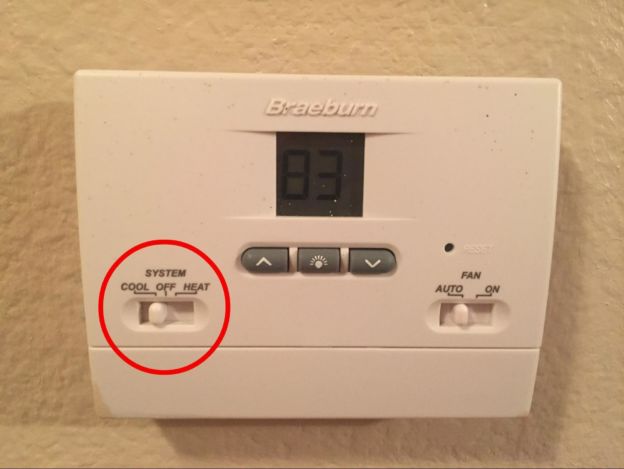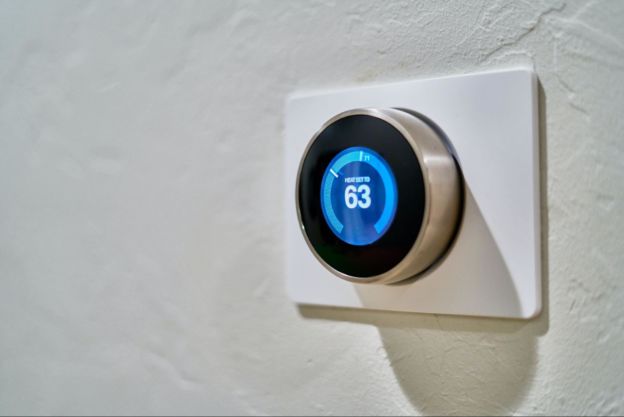3 Ways To Save Money With Your Thermostat
June 24, 2021
We know that looking at utility bills can be painful and that saving money is top of mind for most Floridians during summer. Luckily, your thermostat can actually help you save money. Not many people know that easy tricks with your thermostat can significantly impact your energy savings.
Using your thermostat in three specific ways can prevent utilities from guzzling all your money:
- Keep your thermostat settings on AUTO
- Keep your thermostat turned on at the temperature you want
- Increase the temperature when you’re out or during peak hours
Read on to learn how you can save as much money as possible this summer.
Want to save even more money this summer? Schedule an AC tune-up with Advanced Air.
Way #1: Keep your thermostat settings on AUTO

If you’ve ever wondered about the difference between your thermostat’s ON and AUTO settings, you’re not alone. ON and AUTO are two thermostat settings that control the blower fan in your indoor AC unit. They have an enormous impact on the temperature and humidity levels in your home—and Florida homes definitely don’t need any more humidity.
First, let’s cover the difference between the two settings. A thermostat set to ON means the fan will constantly run, even if the AC isn’t currently cooling your home. Meanwhile, a thermostat set to AUTO means the fan only runs when the AC is cooling the air.
Despite popular belief, turning the fan to ON during the summer will not cool your place more or faster. Instead, the fan is just circulating warm air around your home.
Three main problems occur when the fan is running nonstop:
- The AC fan uses electrical energy, so when it’s on constantly, it consumes more energy and your utility bills skyrocket.
- AC systems not only cool your home but also dehumidify it. However, when the fan is constantly running, the AC cannot strip humidity from your home's air by absorbing and dumping the moisture. When the fan keeps going, the moisture cannot be collected and drained outdoors.
- You must replace your air filter more often. Because the blower fan running helps blow airborne particles into your AC system for the AC filter to trap, your AC filter can get dirty way faster than average. So, if you put your thermostat on the ON setting but don’t replace your air filter more frequently, the clogged air filter can overextend your AC system.
Keeping your thermostat settings on AUTO forces the fan to shut off in between cooling cycles, allowing the AC to dehumidify the air. AUTO is the most energy-efficient and cost-efficient option.
You might wonder if there’s ever a scenario where it’s better to use your thermostat’s ON setting. One exception is during dusting or vacuuming. Since the vacuum kicks up a large amount of dust in your home, the AC fan running can help suck the dust into your air filters to be trapped instead of falling back onto your carpet and furniture.
Pro-tip: If you want both the cleaner air benefits of the ON setting but the energy efficiency of the AUTO setting, look into getting a two-stage AC system. The two-stage system has a compressor that allows it to run at lower speeds in milder weather instead of full blast. That way, the blower fan runs more often, helping your air filter trap more contaminants, but you aren’t overpaying for it.
Way #2: Keep your thermostat turned on at the temperature you want

Let’s address two common thermostat mistakes homeowners make: turning off their AC when they leave the house and setting the temperature super low, thinking that will help them save money or cool their home faster.
Unfortunately, that’s not what happens. Turning off the AC or setting the temperature super low just wastes money.
Don’t turn off your AC
If you’re going out and don’t want to pay for your empty home to be cooled, you might turn off your system entirely to save money.
However, shutting off your system means that your AC will have to work incredibly hard once it’s turned back on to make up for the temperature difference as your house has heated up to outdoor temperatures. For example, if you’ve left for vacation and come back to 98-degree weather and you want your house to be at 70 degrees, your system now has to cool it down by 28 degrees. It's difficult for your AC to produce such a large amount of cool air in a short time and will most likely overstrain itself.
Do this instead: Turn up your thermostat when you’re out of the house, which we’ll go into more detail on the next tip. For example, just turning your thermostat up to 78 degrees while you’re out, your AC system now only has to cool your home by 8 degrees when you come back, which is half of the temperature differential it would have had to meet if you turned off your thermostat.
Put the thermostat at the temperature you want
Setting the thermostat at a super low temperature does not cool your home faster. It has the opposite effect and forces your AC to run even longer. And the longer the AC runs, the more energy it consumes and the more money you have to pay for your energy bills.
Do this instead: Set your thermostat to the temperature you actually want. Waiting for your house to cool down to the right temperature will prevent unnecessary money wasting.
Way #3: Increase the temperature when you’re out or during peak hours

Like we talked about above, instead of shutting off your thermostat, simply increase the temperature while you’re gone or during peak demand to save money.
Increase the temperature when you’re out
According to the US Department of Energy, setting your thermostat a few degrees higher while you’re gone for 8 hours or more can shave up to 10% off your yearly energy bills. You can also save money by raising the temperature while you’re asleep.
For example, if your house is typically set at 70 degrees, turning your thermostat up to 79 degrees when you leave for work/errands/vacation or sleep, then turning it back down to 70 degrees later can save you almost 10% a year.
If you have a regular schedule for when you’ll be out of the house, it can be a good idea to invest in a programmable thermostat. This way you avoid the risk of forgetting to turn up your thermostat when you’re away, and will have a guaranteed cool home when you return.
So, if your desired temperature is 70 degrees, let’s look at a hypothetical programmed schedule:
- 7:30am — The thermostat automatically raises your home’s temperature from 70° to 79° when you leave your house for work
- 4:30pm — The thermostat automatically starts to lower the temperature back to 70° when you leave work to go home
- 5:00pm — By the time you get home, you arrive at a comfortable home.
As you can see, your house will be back to your desired temperature by the time you get home from work. And the programmable thermostat will remember to do this every day, so you don’t have to lift a finger.
Increase the temperature during peak demand
If you’re at home most days and still want to save money, you can increase your thermostat during peak demand to avoid paying expensive rates. Many utility companies require you to pay more if you consume more energy during certain peak hours. For example, FPL’s peak hours are from 12pm-9pm during the summer months.
Raising the temperature by 7-10 degrees can be unfathomable when you’re home, which is where ceiling fans can kick in. According to Energy.gov, a ceiling fan can “allow you to raise the thermostat setting about 4°F with no reduction in comfort.”
Fans cool you off using the “wind-chill effect,” where moving air speeds up our body’s natural cooling process. You can stay cool and comfortable using ceiling fans while increasing your thermostat to avoid peak hour energy costs. Remember that fans cool people, not rooms. Keep the fans turned off in unoccupied rooms.
Want to save money this summer? Advanced Air can help!
If you’ve kept your thermostat on the ON setting, we can provide you with an AC tune-up to check on your blower fan, filter and if any damage has been caused to your AC system.
We can also help you buy a programmable thermostat or a 2-stage AC system. We provide free, no-obligation AC installation estimates in just seconds.
When you schedule with Advanced Air, you always get 100% customer satisfaction and no sneaky pricing schemes.
- Posted in:
- Air Conditioning

